Figure 2. Jablonski diagram illustrating the processes involved in the creation of an excited electronic singlet state by optical absorption and subsequent emission of fluorescence. The labeled stages 1, 2 and 3 are explained in the adjoining text.
Page Contents
Fluorescent probes enable researchers to detect particular components of complex biomolecular assemblies, such as live cells, with exquisite sensitivity and selectivity. The purpose of this introduction is to briefly outline fluorescence principles and techniques for newcomers to the field.
Fluorescence is the result of a three-stage process that occurs in certain molecules (generally polyaromatic hydrocarbons or heterocycles) called fluorophores or fluorescent dyes (Figure 1). A fluorescent probe is a fluorophore designed to respond to a specific stimulus or to localize within a specific region of a biological specimen. The process responsible for the fluorescence of fluorescent probes and other fluorophores is illustrated by the simple electronic-state diagram (Jablonski diagram) shown in Figure 2.
Figure 1. Molecular Probes tutorial series—Introduction to fluorescence. This tutorial provides an overview of the basic principles of fluorescence.
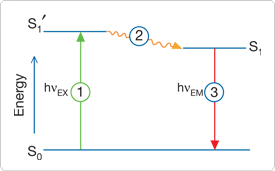
Stage 1: Excitation
A photon of energy hνEX is supplied by an external source such as an incandescent lamp or a laser and absorbed by the fluorophore, creating an excited electronic singlet state (S1'). This process distinguishes fluorescence from chemiluminescence, in which the excited state is populated by a chemical reaction.
Stage 2: Excited-State Lifetime
The excited state exists for a finite time (typically 1–10 nanoseconds). During this time, the fluorophore undergoes conformational changes and is also subject to a multitude of possible interactions with its molecular environment. These processes have two important consequences. First, the energy of S1' is partially dissipated, yielding a relaxed singlet excited state (S1) from which fluorescence emission originates. Second, not all the molecules initially excited by absorption (Stage 1) return to the ground state (S0) by fluorescence emission. Other processes such as collisional quenching, fluorescence resonance energy transfer (FRET) (Fluorescence Resonance Energy Transfer (FRET)—Note 1.2) and intersystem crossing (see below) may also depopulate S1. The fluorescence quantum yield, which is the ratio of the number of fluorescence photons emitted (Stage 3) to the number of photons absorbed (Stage 1), is a measure of the relative extent to which these processes occur.
Stage 3: Fluorescence Emission
A photon of energy hνEM is emitted, returning the fluorophore to its ground state S0. Due to energy dissipation during the excited-state lifetime, the energy of this photon is lower, and therefore of longer wavelength, than the excitation photon hνEX. The difference in energy or wavelength represented by (hνEX – hνEM) is called the Stokes shift. The Stokes shift is fundamental to the sensitivity of fluorescence techniques because it allows emission photons to be detected against a low background, isolated from excitation photons. In contrast, absorption spectrophotometry requires measurement of transmitted light relative to high incident light levels at the same wavelength.
Fluorescence Spectra
The entire fluorescence process is cyclical. Unless the fluorophore is irreversibly destroyed in the excited state (an important phenomenon known as photobleaching, see below), the same fluorophore can be repeatedly excited and detected. The fact that a single fluorophore can generate many thousands of detectable photons is fundamental to the high sensitivity of fluorescence detection techniques. For polyatomic molecules in solution, the discrete electronic transitions represented by hνEX and hνEM in Figure 2 are replaced by rather broad energy spectra called the fluorescence excitation spectrum and fluorescence emission spectrum, respectively (Figure 3, Table 1). The bandwidths of these spectra are parameters of particular importance for applications in which two or more different fluorophores are simultaneously detected (see below). The fluorescence excitation spectrum of a single fluorophore species in dilute solution is usually identical to its absorption spectrum. The absorption spectrum can therefore be used as a surrogate excitation spectrum data set. Under the same conditions, the fluorescence emission spectrum is independent of the excitation wavelength, due to the partial dissipation of excitation energy during the excited-state lifetime, as illustrated in Figure 2. The emission intensity is proportional to the amplitude of the fluorescence excitation spectrum at the excitation wavelength (Figure 4).
Figure 3. Molecular Probes tutorial series—Anatomy of fluorescence spectra. This tutorial describes the information provided in the fluorescence excitation and emission spectra of a fluorophore.
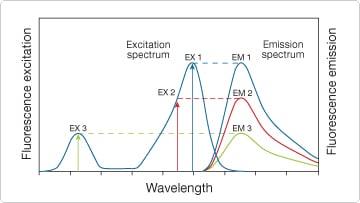
Figure 4. Excitation of a fluorophore at three different wavelengths (EX 1, EX 2, EX 3) does not change the emission profile but does produce variations in fluorescence emission intensity (EM 1, EM 2, EM 3) that correspond to the amplitude of the excitation spectrum.
Table 1. Spectroscopic properties of fluorescent dyes.
| Property | Definition | Significance |
|---|---|---|
| Fluorescence excitation spectrum * | An X,Y plot of excitation wavelength versus number of fluorescence photons generated by a fluorophore. | Optimum instrument setup should deliver excitation light as close to the peak of the excitation spectrum of the fluorophore as possible. |
| Absorption spectrum | An X,Y plot of wavelength versus absorbance of a chromophore or fluorophore. | To a first approximation, the absorption spectrum of a fluorophore is equivalent to the fluorescence excitation spectrum.† To the extent that this approximation holds, the absorption spectrum can be used as a surrogate for the fluorescence excitation spectrum. |
| Fluorescence emission spectrum * | An X,Y plot of emission wavelength versus number of fluorescence photons generated by a fluorophore. | Fluorescence emission spectral discrimination is the most straightforward basis for multiplex detection ‡ and for resolving probe fluorescence from background autofluorescence. |
| Extinction coefficient (EC) | Capacity for light absorption at a specific wavelength.§ | Fluorescence output per fluorophore (“brightness”) is proportional to the product of the extinction coefficient (at the relevant excitation wavelength) and the fluorescence quantum yield. |
| Fluorescence quantum yield (QY) | Number of fluorescence photons emitted per excitation photon absorbed. | See “Extinction coefficient.” |
| Quenching | Loss of fluorescence signal due to short-range interactions between the fluorophore and the local molecular environment, including other fluorophores (self-quenching). | Loss of fluorescence is reversible to the extent that the causative molecular interactions can be controlled.** |
| Photobleaching | Destruction of the excited fluorophore due to photosensitized generation of reactive oxygen species (ROS), particularly singlet oxygen (1O2). | Loss of fluorescence signal is irreversible if the bleached fluorophore population is not replenished (e.g., via diffusion). Extent of photobleaching is dependent on the duration and intensity of exposure to excitation light. |
* Our online Fluorescence SpectraViewer provides an interactive utility for plotting and comparing fluorescence excitation and emission spectra for over 250 fluorophores (Using the Fluorescence SpectraViewer—Note 23.1). | ||
Fluorescence Instrumentation
Four essential elements of fluorescence detection systems can be identified from the preceding discussion: 1) an excitation light source (Figure 5), 2) a fluorophore, 3) wavelength filters to isolate emission photons from excitation photons (Figure 5), 4) a detector that registers emission photons and produces a recordable output, usually as an electrical signal. Regardless of the application, compatibility of these four elements is essential for optimizing fluorescence detection.
Fluorescence instruments are primarily of four types, each providing distinctly different information:
- Spectrofluorometers and microplate readers measure the average properties of bulk (µL to mL) samples.
- Fluorescence microscopes resolve fluorescence as a function of spatial coordinates in two or three dimensions for microscopic objects (less than ~0.1 mm diameter).
- Fluorescence scanners, including microarray readers, resolve fluorescence as a function of spatial coordinates in two dimensions for macroscopic objects such as electrophoresis gels, blots and chromatograms.
- Flow cytometers measure fluorescence per cell in a flowing stream, allowing subpopulations within a large sample to be identified and quantitated (Figure 6).
Other types of instrumentation that use fluorescence detection include capillary electrophoresis apparatus, DNA sequencers ![]() and microfluidic devices.
and microfluidic devices.![]() Each type of instrument produces different measurement artifacts and makes different demands on the fluorescent probe. For example, although photobleaching is often a significant problem in fluorescence microscopy, it is not a major impediment in flow cytometry because the dwell time of individual cells in the excitation beam is short.
Each type of instrument produces different measurement artifacts and makes different demands on the fluorescent probe. For example, although photobleaching is often a significant problem in fluorescence microscopy, it is not a major impediment in flow cytometry because the dwell time of individual cells in the excitation beam is short.
Figure 5. Molecular Probes tutorial series—Overview of filters and light sources. This tutorial describes how fluorescence filters work, as well as the various light sources used for fluorescence excitation.
Figure 6. Molecular Probes tutorial series—Introduction to flow cytometry. This tutorial describes the systems that make up a flow cytometer, and how those systems work together to collect information on individual cells as they pass through the flow cytometer's laser beam.
Fluorescence Signals
Fluorescence intensity is quantitatively dependent on the same parameters as absorbance—defined by the Beer–Lambert law as the product of the molar extinction coefficient, optical path length and solute concentration—as well as on the fluorescence quantum yield of the dye and the excitation source intensity and fluorescence collection efficiency of the instrument (Table 1). In dilute solutions or suspensions, fluorescence intensity is linearly proportional to these parameters. When sample absorbance exceeds about 0.05 in a 1 cm pathlength, the relationship becomes nonlinear and measurements may be distorted by artifacts such as self-absorption and the inner-filter effect.![]()
Because fluorescence quantitation is dependent on the instrument, fluorescent reference standards are essential for calibrating measurements made at different times or using different instrument configurations.![]() To meet these requirements, we offer high-precision fluorescent microsphere reference standards for fluorescence microscopy and flow cytometry and a set of ready-made fluorescent standard solutions for spectrofluorometry (Fluorescence Microscopy Accessories and Reference Standards—Section 23.1, Flow Cytometry Reference Standards—Section 23.2).
To meet these requirements, we offer high-precision fluorescent microsphere reference standards for fluorescence microscopy and flow cytometry and a set of ready-made fluorescent standard solutions for spectrofluorometry (Fluorescence Microscopy Accessories and Reference Standards—Section 23.1, Flow Cytometry Reference Standards—Section 23.2).
A spectrofluorometer is extremely flexible, providing continuous ranges of excitation and emission wavelengths. Laser-scanning microscopes and flow cytometers, however, require probes that are excitable at a single fixed wavelength. In contemporary instruments, the excitation source is usually the 488 nm spectral line of the argon-ion laser. As shown in Figure 7, separation of the fluorescence emission signal (S1) from Rayleigh-scattered excitation light (EX) is facilitated by a large fluorescence Stokes shift (i.e., separation of A1 and E1). Biological samples labeled with fluorescent probes typically contain more than one fluorescent species, making signal-isolation issues more complex. Additional optical signals, represented in Figure 7 as S2, may be due to background fluorescence or to a second fluorescent probe.
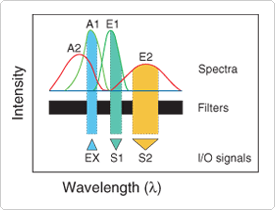
Figure 7. Fluorescence detection of mixed species. Excitation (EX) in overlapping absorption bands A1 and A2 produces two fluorescent species with spectra E1 and E2. Optical filters isolate quantitative emission signals S1 and S2.
Background Fluorescence
Fluorescence detection sensitivity is severely compromised by background signals, which may originate from endogenous sample constituents (referred to as autofluorescence) or from unbound or nonspecifically bound probes (referred to as reagent background). Detection of autofluorescence can be minimized either by selecting filters that reduce the transmission of E2 relative to E1 or by selecting probes that absorb and emit at longer wavelengths. Although narrowing the fluorescence detection bandwidth increases the resolution of E1 and E2, it also compromises the overall fluorescence intensity detected. Signal distortion caused by autofluorescence of cells, tissues and biological fluids is most readily minimized by using probes that can be excited at >500 nm. Furthermore, at longer wavelengths, light scattering by dense media such as tissues is much reduced, resulting in greater penetration of the excitation light.![]()
Multicolor Labeling Experiments
A multicolor labeling experiment entails the deliberate introduction of two or more probes to simultaneously monitor different biochemical functions. This technique has major applications in flow cytometry,![]() DNA sequencing,
DNA sequencing,![]() fluorescence in situ hybridization
fluorescence in situ hybridization ![]() and fluorescence microscopy.
and fluorescence microscopy.![]() Signal isolation and data analysis are facilitated by maximizing the spectral separation of the multiple emissions (E1 and E2 in Figure 7). Consequently, fluorophores with narrow emission spectral bandwidths, such as BODIPY dyes (BODIPY Dye Series—Section 1.4) and Qdot nanocrystals (Qdot Nanocrystals—Section 6.6), are particularly useful in multicolor applications. An ideal combination of dyes for multicolor labeling would exhibit strong absorption at a coincident excitation wavelength and well-separated emission spectra (Figure 7). Unfortunately, it is not easy to find single dyes with the requisite combination of a large extinction coefficient for absorption and a large Stokes shift. Qdot nanocrystals (Qdot Nanocrystals—Section 6.6) and phycobiliprotein tandem conjugates (Phycobiliproteins—Section 6.4) have been developed to meet these requirements and have proven effective in multicolor labeling experiments.
Signal isolation and data analysis are facilitated by maximizing the spectral separation of the multiple emissions (E1 and E2 in Figure 7). Consequently, fluorophores with narrow emission spectral bandwidths, such as BODIPY dyes (BODIPY Dye Series—Section 1.4) and Qdot nanocrystals (Qdot Nanocrystals—Section 6.6), are particularly useful in multicolor applications. An ideal combination of dyes for multicolor labeling would exhibit strong absorption at a coincident excitation wavelength and well-separated emission spectra (Figure 7). Unfortunately, it is not easy to find single dyes with the requisite combination of a large extinction coefficient for absorption and a large Stokes shift. Qdot nanocrystals (Qdot Nanocrystals—Section 6.6) and phycobiliprotein tandem conjugates (Phycobiliproteins—Section 6.4) have been developed to meet these requirements and have proven effective in multicolor labeling experiments.![]()
Ratiometric Measurements
In some cases—for example the Ca2+ indicators fura-2 and indo-1 (Fluorescent Ca2+ Indicators Excited with UV Light—Section 19.2) and the pH indicators BCECF and SNARF (Probes Useful at Near-Neutral pH—Section 20.2)—the free and ion-bound forms of fluorescent ion indicators have different emission or excitation spectra. With this type of indicator, the ratio of the optical signals (S1 and S2 in Figure 7) can be used to monitor the association equilibrium and to calculate ion concentrations. Ratiometric measurements eliminate distortions of data caused by photobleaching and variations in probe loading and retention, as well as by instrumental factors such as illumination stability ![]() (Loading and Calibration of Intracellular Ion Indicators—Note 19.1).
(Loading and Calibration of Intracellular Ion Indicators—Note 19.1).
Comparing Different Dyes
Fluorophores currently used as fluorescent probes offer sufficient permutations of wavelength range, Stokes shift and spectral bandwidth to meet requirements imposed by instrumentation (e.g., 488 nm excitation), while allowing flexibility in the design of multicolor labeling experiments. Our online Fluorescence SpectraViewer provides an interactive utility for evaluating these factors during the experimental design process (Using the Fluorescence SpectraViewer—Note 23.1). The fluorescence output of a given dye depends on the efficiency with which it absorbs and emits photons, and its ability to undergo repeated excitation/emission cycles. Absorption and emission efficiencies are most usefully quantified in terms of the molar extinction coefficient (EC) for absorption and the quantum yield (QY) for fluorescence. Both are constants under specific environmental conditions. The value of EC is specified at a single wavelength (usually the absorption maximum), whereas QY is a measure of the total photon emission over the entire fluorescence spectral profile. Fluorescence intensity per dye molecule is proportional to the product of EC and QY (Table 1). The range of these parameters among organic dye and autofluorescent protein fluorophores is approximately 5000 to 200,000 cm-1M-1 for EC and 0.05 to 1.0 for QY. Phycobiliproteins such as R-phycoerythrin (Phycobiliproteins—Section 6.4) have multiple fluorophores on each protein and consequently have much larger extinction coefficients (on the order of 2 × 106 cm-1M-1) than low molecular weight fluorophores. Molecular Probes™ Qdot nanocrystals have even larger extinction coefficients (>2 × 106 cm-1M-1), particularly in the blue visible and ultraviolet wavelength regions (Qdot Nanocrystals—Section 6.6).
Photobleaching
Under high-intensity illumination conditions, the irreversible destruction or photobleaching of the excited fluorophore becomes the primary factor limiting fluorescence detectability. The multiple photochemical reaction pathways responsible for photobleaching have been investigated and described in considerable detail.![]() Some pathways include reactions between adjacent dye molecules, making the process considerably more complex in labeled biological specimens than in dilute solutions of free dye. In all cases, photobleaching originates from the triplet excited state, which is created from the singlet state (S1, Figure 2) via an excited-state process called intersystem crossing.
Some pathways include reactions between adjacent dye molecules, making the process considerably more complex in labeled biological specimens than in dilute solutions of free dye. In all cases, photobleaching originates from the triplet excited state, which is created from the singlet state (S1, Figure 2) via an excited-state process called intersystem crossing.![]()
The most effective remedy for photobleaching is to maximize detection sensitivity, which allows the excitation intensity to be reduced. Detection sensitivity is enhanced by low-light detection devices such as CCD cameras, as well as by high–numerical aperture objectives and the widest bandpass emission filters compatible with satisfactory signal isolation. Alternatively, a less photolabile fluorophore may be substituted in the experiment.![]() Molecular Probes™ Alexa Fluor 488 dye is an important fluorescein substitute that provides significantly greater photostability than fluorescein (Figure 8, Figure 9,
Molecular Probes™ Alexa Fluor 488 dye is an important fluorescein substitute that provides significantly greater photostability than fluorescein (Figure 8, Figure 9, ![]() ), yet is compatible with standard fluorescein optical filters. Antifade reagents such as Molecular Probes™ SlowFade and ProLong reagents (Fluorescence Microscopy Accessories and Reference Standards—Section 23.1) can also be applied to reduce photobleaching; however, they are usually incompatible with live cells. In general, it is difficult to predict the necessity for and effectiveness of such countermeasures because photobleaching rates are dependent to some extent on the fluorophore's environment.
), yet is compatible with standard fluorescein optical filters. Antifade reagents such as Molecular Probes™ SlowFade and ProLong reagents (Fluorescence Microscopy Accessories and Reference Standards—Section 23.1) can also be applied to reduce photobleaching; however, they are usually incompatible with live cells. In general, it is difficult to predict the necessity for and effectiveness of such countermeasures because photobleaching rates are dependent to some extent on the fluorophore's environment.![]()
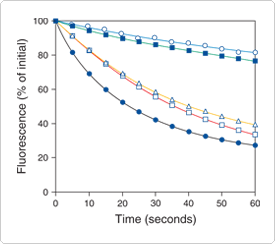
Figure 8. Comparison of photostability of green-fluorescent antibody conjugates. The following fluorescent goat anti–mouse IgG antibody conjugates were used to detect mouse anti–human IgG antibody labeling of human anti-nuclear antibodies in HEp-2 cells on prefixed test slides (INOVA Diagnostics Corp.): Alexa Fluor 488 (A11001, ![]() ), Oregon Green 514 (
), Oregon Green 514 (![]() ), BODIPY FL (B2752,
), BODIPY FL (B2752, ![]() ), Oregon Green 488 (
), Oregon Green 488 (![]() ) or fluorescein (F2761,
) or fluorescein (F2761, ![]() ). Samples were continuously illuminated and viewed on a fluorescence microscope using a fluorescein longpass filter set. Images were acquired every 5 seconds. For each conjugate, three data sets, representing different fields of view, were averaged and then normalized to the same initial fluorescence intensity value to facilitate comparison.
). Samples were continuously illuminated and viewed on a fluorescence microscope using a fluorescein longpass filter set. Images were acquired every 5 seconds. For each conjugate, three data sets, representing different fields of view, were averaged and then normalized to the same initial fluorescence intensity value to facilitate comparison.
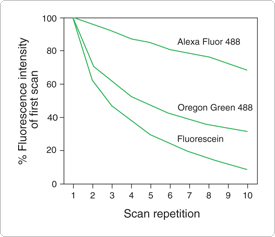
Figure 9. Photobleaching resistance of the green-fluorescent Alexa Fluor 488, Oregon Green 488 and fluorescein dyes, as determined by laser-scanning cytometry. EL4 cells were labeled with biotin-conjugated anti-CD44 antibody and detected by Alexa Fluor 488 (S11223, S32354), Oregon Green 488 or fluorescein (S869) streptavidin (Avidin, Streptavidin, NeutrAvidin and CaptAvidin Biotin-Binding Proteins and Affinity Matrices—Section 7.6). The cells were then fixed in 1% formaldehyde, washed and wet-mounted. After mounting, cells were scanned 10 times on a laser-scanning cytometer; laser power levels were 25 mW for the 488 nm spectral line of the argon-ion laser. Scan durations were approximately 5 minutes, and each repetition was started immediately after completion of the previous scan. Data are expressed as percentages derived from the mean fluorescence intensity (MFI) of each scan divided by the MFI of the first scan. Data contributed by Bill Telford, Experimental Transplantation and Immunology Branch, National Cancer Institute.
Signal Amplification
The most straightforward way to enhance fluorescence signals is to increase the number of fluorophores available for detection.![]() Fluorescent signals can be amplified using 1) avidin–biotin or antibody–hapten secondary detection techniques, 2) enzyme-labeled secondary detection reagents in conjunction with fluorogenic substrates
Fluorescent signals can be amplified using 1) avidin–biotin or antibody–hapten secondary detection techniques, 2) enzyme-labeled secondary detection reagents in conjunction with fluorogenic substrates ![]() or 3) probes that contain multiple fluorophores such as phycobiliproteins or FluoSpheres fluorescent microspheres. Our most sensitive reagents and methods for signal amplification are discussed in Ultrasensitive Detection Technology—Chapter 6.
or 3) probes that contain multiple fluorophores such as phycobiliproteins or FluoSpheres fluorescent microspheres. Our most sensitive reagents and methods for signal amplification are discussed in Ultrasensitive Detection Technology—Chapter 6.
Simply increasing the probe concentration can be counterproductive and often produces marked changes in the probe's chemical and optical characteristics. It is important to note that the effective intracellular concentration of probes loaded by bulk permeabilization methods (Loading and Calibration of Intracellular Ion Indicators—Note 19.1) is usually much higher (>10-fold) than the extracellular incubation concentration. Also, increased labeling of proteins or membranes ultimately leads to precipitation of the protein or gross changes in membrane permeability. Antibodies labeled with more than four to six fluorophores per protein may exhibit reduced specificity and reduced binding affinity. Furthermore, at high degrees of substitution, the extra fluorescence obtained per added fluorophore typically decreases due to self-quenching (Figure 10).
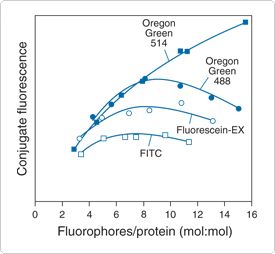
Figure 10. Comparison of relative fluorescence as a function of the number of fluorophores attached per protein for goat anti–mouse IgG antibody conjugates prepared using Oregon Green 514 carboxylic acid succinimidyl ester (O6139, ![]() ), Oregon Green 488 carboxylic acid succinimidyl ester (O6147,
), Oregon Green 488 carboxylic acid succinimidyl ester (O6147, ![]() ), fluorescein-5-EX succinimidyl ester (F6130,
), fluorescein-5-EX succinimidyl ester (F6130, ![]() ) and fluorescein isothiocyanate (FITC; F143, F1906, F1907;
) and fluorescein isothiocyanate (FITC; F143, F1906, F1907; ![]() ). Conjugate fluorescence is determined by measuring the fluorescence quantum yield of the conjugated dye relative to that of the free dye and multiplying by the number of fluorophores per protein.
). Conjugate fluorescence is determined by measuring the fluorescence quantum yield of the conjugated dye relative to that of the free dye and multiplying by the number of fluorophores per protein.
Fluorescence spectra and quantum yields are generally more dependent on the environment than absorption spectra and extinction coefficients. For example, coupling a single fluorescein label to a protein typically reduces fluorescein's QY ~60% but only decreases its EC by ~10%. Interactions either between two adjacent fluorophores or between a fluorophore and other species in the surrounding environment can produce environment-sensitive fluorescence.
Fluorophore–Fluorophore Interactions
Fluorescence quenching can be defined as a bimolecular process that reduces the fluorescence quantum yield without changing the fluorescence emission spectrum (Table 1); it can result from transient excited-state interactions (collisional quenching) or from formation of nonfluorescent ground-state species. Self-quenching is the quenching of one fluorophore by another;![]() it therefore tends to occur when high loading concentrations or labeling densities are used (Figure 10, Figure 11). DQ substrates (Detecting Peptidases and Proteases—Section 10.4) are heavily labeled and therefore highly quenched biopolymers that exhibit dramatic fluorescence enhancement upon enzymatic cleavage
it therefore tends to occur when high loading concentrations or labeling densities are used (Figure 10, Figure 11). DQ substrates (Detecting Peptidases and Proteases—Section 10.4) are heavily labeled and therefore highly quenched biopolymers that exhibit dramatic fluorescence enhancement upon enzymatic cleavage ![]() (Figure 12).
(Figure 12).
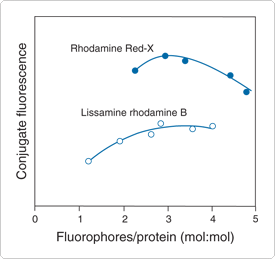
Figure 11. Comparison of the relative fluorescence of goat anti–mouse IgG antibody conjugates of Rhodamine Red-X succinimidyl ester (R6160, ![]() ) and Lissamine rhodamine B sulfonyl chloride (
) and Lissamine rhodamine B sulfonyl chloride (![]() ). Conjugate fluorescence is determined by measuring the fluorescence quantum yield of the conjugated dye relative to that of the free dye and multiplying by the number of fluorophores per protein. Higher numbers of fluorophores attached per protein are attainable with Rhodamine Red-X dye due to the lesser tendency of this dye to induce protein precipitation.
). Conjugate fluorescence is determined by measuring the fluorescence quantum yield of the conjugated dye relative to that of the free dye and multiplying by the number of fluorophores per protein. Higher numbers of fluorophores attached per protein are attainable with Rhodamine Red-X dye due to the lesser tendency of this dye to induce protein precipitation.![]()
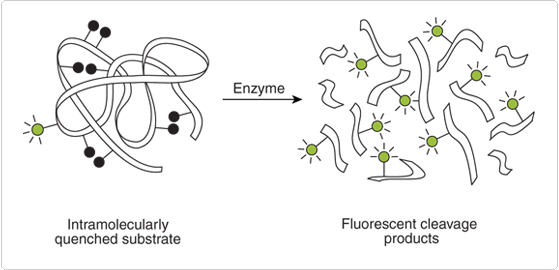
Figure 12. Principle of enzyme detection via the disruption of intramolecular self-quenching. Enzyme-catalyzed hydrolysis of the heavily labeled and almost totally quenched substrates provided in the EnzChek Assay Kits relieves the intramolecular self-quenching, yielding brightly fluorescent reaction products. Also available are stand-alone quenched substrates, including DQ BSA (D12050, D12051), DQ collagen (D12052, D12060), DQ ovalbumin (D12053) and DQ gelatin (D12054).
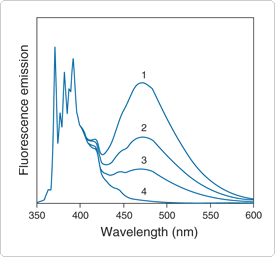
Figure 13. Excimer formation by pyrene in ethanol. Spectra are normalized to the 371.5 nm peak of the monomer. All spectra are essentially identical below 400 nm after normalization. Spectra are as follows: 1) 2 mM pyrene, purged with argon to remove oxygen; 2) 2 mM pyrene, air-equilibrated; 3) 0.5 mM pyrene (argon-purged); and 4) 2 µM pyrene (argon-purged). The monomer-to-excimer ratio (371.5/470 nm) is dependent on both pyrene concentration and the excited-state lifetime, which is variable because of quenching by oxygen.
Other Environmental Factors
Many other environmental factors exert influences on fluorescence properties. The three most common are:
- Solvent polarity (solvent in this context includes interior regions of cells, proteins, membranes and other biomolecular structures)
- Proximity and concentrations of quenching species
- pH of the aqueous medium
Fluorescence spectra may be strongly dependent on solvent. This characteristic is most often observed with fluorophores that have large excited-state dipole moments, resulting in fluorescence spectral shifts to longer wavelengths in polar solvents. Representative fluorophores include the aminonaphthalenes such as prodan, badan (Figure 14) and dansyl, which are effective probes of environmental polarity in, for example, a protein's interior.![]()
Binding of a probe to its target can dramatically affect its fluorescence quantum yield (Monitoring Protein-Folding Processes with Environment-Sensitive Dyes—Note 9.1). Probes that have a high fluorescence quantum yield when bound to a particular target but are otherwise effectively nonfluorescent yield extremely low reagent background signals. The ultrasensitive SYBR, SYTO, PicoGreen, RiboGreen and OliGreen nucleic acid stains (Nucleic Acid Detection and Analysis—Chapter 8) are prime examples of this strategy. Similarly, fluorogenic enzyme substrates, which are nonfluorescent or have only short-wavelength emission until they are converted to fluorescent products by enzymatic cleavage, allow sensitive detection of enzymatic activity (Enzyme Substrates and Assays—Chapter 10).
Extrinsic quenchers, the most ubiquitous of which are paramagnetic species such as O2 and heavy atoms such as iodide, reduce fluorescence quantum yields in a concentration-dependent manner. If quenching is caused by collisional interactions, as is usually the case, information on the proximity of the fluorophore and quencher and their mutual diffusion rate can be derived. This quenching effect has been used productively to measure chloride-ion flux in cells (Detecting Chloride, Phosphate, Nitrite and Other Anions—Section 21.2). Many fluorophores are also quenched by proteins. Examples are Alexa Fluor, fluorescein and BODIPY dyes, in which the effect is apparently due to charge-transfer interactions with aromatic amino acid residues.![]() Consequently, antibodies raised against these fluorophores are effective and highly specific fluorescence quenchers
Consequently, antibodies raised against these fluorophores are effective and highly specific fluorescence quenchers ![]() (Anti-Dye and Anti-Hapten Antibodies—Section 7.4).
(Anti-Dye and Anti-Hapten Antibodies—Section 7.4).
Fluorophores such as BCECF and carboxy SNARF-1 that have strongly pH-dependent absorption and fluorescence characteristics can be used as physiological pH indicators. Fluorescein and hydroxycoumarins (umbelliferones) are further examples of this type of fluorophore. Structurally, pH sensitivity is due to a reconfiguration of the fluorophore's π-electron system that occurs upon protonation. BODIPY FL and Alexa Fluor 488 fluorophores, both of which lack proteolytically ionizable substituents, provide spectrally equivalent alternatives to fluorescein for applications requiring a pH-insensitive probe (Alexa Fluor Dyes Spanning the Visible and Infrared Spectrum—Section 1.3, BODIPY Dye Series—Section 1.4).
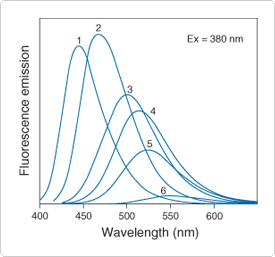
Figure 14. Fluorescence emission spectra of the 2-mercaptoethanol adduct of badan (B6057) in: 1) toluene, 2) chloroform, 3) acetonitrile, 4) ethanol, 5) methanol and 6) water. Each solution contains the same concentration of the adduct. Excitation of all samples is at 380 nm.
The preceding discussion has introduced some general principles to consider when selecting a fluorescent probe. Application-specific details are addressed in subsequent chapters of the Molecular Probes Handbook. For in-depth treatments of fluorescence techniques and their biological applications, the reader is referred to the many excellent books and review articles listed below.
Principles of Fluorescence Detection
- Albani, J.R., Absorption et Fluorescence: Principes et Applications, Lavoisier (2001). This book is the first on absorption and fluorescence to be published in the French language.
- Albani, J.R., Principles and Applications of Fluorescence Spectroscopy, Wiley-Blackwell (2007).
- Brand, L. and Johnson, M.L., Eds., Fluorescence Spectroscopy (Methods in Enzymology, Volume 450), Academic Press (2008).
- Gell, C., Brockwell, D. and Smith, A., Handbook of Single Molecule Fluorescence Spectroscopy, Oxford University Press (2006).
- Goldys, E.M., Ed., Fluorescence Applications in Biotechnology and Life Sciences, Wiley-Blackwell (2009).
- Guilbault, G.G., Ed., Practical Fluorescence, Second Edition, Marcel Dekker (1990).
- Joo, C., Balci, H., Ishitsuka, Y., Buranachai, C. and Ha, T., “Advances in single-molecule fluorescence methods for molecular biology,” Annu Rev Biochem (2008) 77:51–76.
- Lakowicz, J.R., Principles of Fluorescence Spectroscopy, Third Edition, Springer (2006).
- Mathies, R.A., Peck, K. and Stryer, L., "Optimization of high-sensitivity fluorescence detection," Anal Chem (1990) 62:1786–1791.
- Royer, C.A., "Approaches to teaching fluorescence spectroscopy," Biophys J (1995) 68:1191–1195.
- Selvin, P.R. and Ha, T., Eds., Single-Molecule Techniques: A Laboratory Manual, Cold Spring Harbor Laboratory Press (2007).
- Valeur, B., Molecular Fluorescence: Principles and Applications, John Wiley and Sons (2002).
Fluorophores and Fluorescent Probes
- Berlman, I.B., Handbook of Fluorescence Spectra of Aromatic Molecules, Second Edition, Academic Press (1971).
- Burry, R.W., Immunocytochemistry: A Practical Guide for Biomedical Research, Springer (2009).
- Chalfie, M. and Kain, S.R., Green Fluorescent Protein: Properties, Applications and Protocols, Second Edition, John Wiley and Sons (2006).
- Drexhage, K.H., "Structure and properties of laser dyes" in Dye Lasers, Third Edition, F.P. Schäfer, Ed., Springer-Verlag, (1990) pp. 155–200.
- Green, F.J., The Sigma-Aldrich Handbook of Stains, Dyes and Indicators, Aldrich Chemical Company (1990).
- Griffiths, J., Colour and Constitution of Organic Molecules, Academic Press (1976).
- Hermanson, G.T., Bioconjugate Techniques, Second Edition, Academic Press (2008).
- Hilderbrand, S.A., “Labels and probes for live cell imaging: Overview and selection guide”, Methods Mol Biol (2010) 581:17–45.
- Kobayashi, H., Ogawa, M., Alford, R., Choyke, P.L. and Urano, Y., “New strategies for fluorescent probe design in medical diagnostic imaging,” Chem Rev (2010) 110:2620–2640.
- Kricka, L.J. and Fortina, P., “Analytical ancestry: "Firsts" in fluorescent labeling of nucleosides, nucleotides, and nucleic acids,” Clin Chem (2009) 55:670–683.
- Liehr, T., Ed., Fluorescence In Situ Hybridization (FISH): Application Guide, Springer (2008).
- Mason, W.T., Ed., Fluorescent and Luminescent Probes for Biological Activity, Second Edition, Academic Press (1999).
- Oliver, C. and Jamur, M.C., Eds., Immunocytochemical Methods and Protocols, Third Edition (Methods in Molecular Biology, Volume 588), Humana Press (2010).
- Taraska, J.W. and Zagotta, W.N., “Fluorescence applications in molecular neurobiology”, Neuron (2010) 66:170–189.
Fluorescence Microscopy
- Frigault, M.M., Lacoste, J., Swift, J.L. and Brown, C.M., “Live-cell microscopy: Tips and tools,” J Cell Sci (2009) 122:753–767.
- Fujimoto, J.G. and Farkas, D., Eds., Biomedical Optical Imaging, Oxford University Press (2009).
- Goldman, R.D., Swedlow, J.R. and Spector, D.L., Eds., Live Cell Imaging: A Laboratory Manual, Second Edition, Cold Spring Harbor Laboratory Press (2009).
- Hell, S.W., “Microscopy and its focal switch,” Nat Methods (2009) 6:24–32.
- Herman, B., Fluorescence Microscopy, Second Edition, BIOS Scientific Publishers (1998).
- Hibbs, A.R., Confocal Microscopy for Biologists, Springer (2004).
- Huang, B., Bates, M. and Zhuang, X., “Super-resolution fluorescence microscopy,” Annu Rev Biochem (2009) 78:993–1016.
- Inoué, S. and Spring, K.R., Video Microscopy, Second Edition, Plenum Publishing (1997).
- Lichtman, J.W. and Conchello, J.A., “Fluorescence microscopy,” Nat Methods (2005) 2:910–919.
- Masters, B.R., Confocal Microscopy and Multiphoton Excitation Microscopy: The Genesis of Live Cell Imaging, SPIE Press (2006).
- Matsumoto, B., Ed., Cell Biological Applications of Confocal Microscopy, Second Edition (Methods in Cell Biology, Volume 70), Academic Press (2003).
- Murphy, D.B., Fundamentals of Light Microscopy and Electronic Imaging, John Wiley and Sons (2001).
- Ntziachristos, V., "Fluorescence molecular imaging," Annu Rev Biomed Eng (2006) 8:1–32.
- Patterson, G., Davidson, M., Manley, S. and Lippincott-Schwartz, J., “Superresolution imaging using single-molecule localization,” Annu Rev Phys Chem (2010) 61:345–367.
- Pawley, J.B., Ed., Handbook of Biological Confocal Microscopy, Third Edition, Springer (2006).
- Periasamy, A., Ed., Methods in Cellular Imaging, Oxford University Press (2001).
- Rosenthal, E. and Zinn, K.R., Eds., Optical Imaging of Cancer: Clinical Applications, Springer (2009).
- Spector, D.L. and Goldman, R.D., Basic Methods in Microscopy, Cold Spring Harbor Laboratory Press (2005).
- Svoboda, K. and Yasuda, R., “Principles of two-photon excitation microscopy and its applications to neuroscience,” Neuron (2006) 50:823–839.
- Tsien, R.Y., " Imagining imaging's future," Nat Rev Mol Cell Biol (2003) 4:SS16–SS21.
- Yuste, R. and Konnerth, A., Eds., Imaging in Neuroscience and Development: A Laboratory Manual, Cold Spring Harbor Laboratory Press (2005).
Flow Cytometry
- Darzynkiewicz, Z., Crissman, H.A. and Robinson, J.P., Eds., Cytometry, Third Edition Parts A and B (Methods in Cell Biology, Volumes 63 and 64), Academic Press (2001).
- Givan, A.L., Flow Cytometry: First Principles, Second Edition, John Wiley and Sons (2001).
- Herzenberg, L.A., Parks, D., Sahaf, B., Perez, O., Roederer, M. and Herzenberg, L.A., "The history and future of the fluorescence activated cell sorter and flow cytometry: A view from Stanford," Clin Chem (2002) 48:1819–1827.
- Herzenberg, L.A., Tung, J., Moore, W.A., Herzenberg, L.A. and Parks, D.R., “Interpreting flow cytometry data: A guide for the perplexed,” Nat Immunol (2006) 7:681–685.
- Preffer F. and Dombkowski, D. “Advances in complex multiparameter flow cytometry technology: Applications in stem cell research,” Cytometry B (2009) 76:295–314.
- Shapiro, H.M., "Optical measurement in cytometry: Light scattering, extinction, absorption and fluorescence," Meth Cell Biol (2001) 63:107–129.
- Shapiro, H.M., Practical Flow Cytometry, Fourth Edition, Wiley-Liss (2003).
- Sklar, L.A., Ed., Flow Cytometry for Biotechnology, Oxford University Press (2005).
Other Fluorescence Measurement Techniques
- Dorak, M.T., Ed., Real-Time PCR, Taylor and Francis (2006).
- Gore, M., Ed., Spectrophotometry and Spectrofluorimetry: A Practical Approach, Second Edition, Oxford University Press (2000).
- Mardis, E.R. “Next-generation DNA sequencing methods,” Annu Rev Genomics Hum Genet (2008) 9:387–402.
- Patton, W.F., "A thousand points of light: The application of fluorescence detection technologies to two-dimensional gel electrophoresis and proteomics," Electrophoresis (2000) 21:1123–1144.
- Shimomura, O., Bioluminescence: Chemical Principles and Methods, World Scientific Publishing (2006).
For Research Use Only. Not for use in diagnostic procedures.